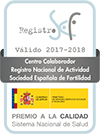
The forms of families have changed and the traditional family is no longer the norm. To commemorate the International Coming Out Day, we have prepared this post to raise awareness for lesbian couples who wish and have the right to start a family.
Lesbian couples can pursue a family with essentially the same assisted reproduction treatments as a heterosexual couple, with the addition of donor sperm.
There is a third option that was authorized thanks to the change in the Spanish Law on Assisted Reproduction (14/2006), which now recognizes that lesbian couples are the legal parents to a child conceived through Assisted Reproduction Techniques. Whether they have carried out the treatment due to medical reasons or because it was simply their wish, non-anonymous egg donation was a legal exception when performed between lesbian partners. Reciprocal IVF, also known as ROPA – Reception of Oocytes from Partner- allows both partners to be physically involved in their child’s conception. Both partners play an important role in building their family: one woman is the biological mother of the child (providing the egg) whilst the other is the gestational mother (carrying the pregnancy and delivering the baby).
Reciprocal IVF- ROPA Method- Reception of Oocytes from Partner
About a decade ago, Reciprocal IVF [link a método Ropa] was not allowed since egg donors must be anonymous. However, in 2006, the change in the Civil Code in Spain recognized the rights of lesbian couples and egg donation between lesbian partners so that they can freely share their gametes, as heterosexual couples do. Since 2007, and according to the current law, lesbian shared motherhood has been legally recognized in Spain. Consequently, babies that are born through a Reciprocal IVF treatment (ROPA) within a lesbian married couple, have two legal mothers, if and when they are married.
How Does Reciprocal IVF Work?
One of the partners provides the eggs to be used in IVF, while the other partner will carry the pregnancy since the obtained embryos are transferred into her uterus.
The Treatment Step-By-Step:
- Ovarian Stimulation for the partner providing the eggs –The partner who is providing the eggs will undergo an ovarian stimulation cycle and the egg retrieval procedure, which is identical to standard IVF procedures.
- Egg Retrieval- Once the follicles have reached a certain size, as measured by ultrasound scan, the eggs are obtained during egg retrieval.
- Fertilization-The collected eggs are mixed with the donor’s sperm in the laboratory. On the next day, they are checked to see if any have been fertilized and the obtained embryos are grown for 3-5 days until they best embryos are selected for transfer.
- Endometrial Preparation-The partner who will carry the pregnancy is prepared for embryo transfer. Simultaneously, she will follow a simple and straightforward treatment that will prepare her uterus and endometrium (the inner lining of the uterus) for embryo transfer and embryo implantation.
- Embryo Transfer- Once the lining is ready for transfer (optima thickness of the endometrium), the best quality embryo is selected and transferred into the uterus of the recipient woman.
Currently Reciprocal IVF is only offered by private fertility clinics in selected countries that permit the treatment as well as homosexual marriage, including Spain.
If you are part of a lesbian couple and are looking to start your family, EVA can help. Starting a family is a wonderful and exciting time and so it should be. We will endeavour to make the journey through treatment as smooth as possible.







